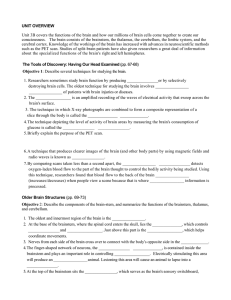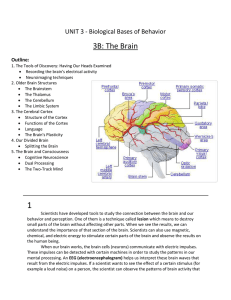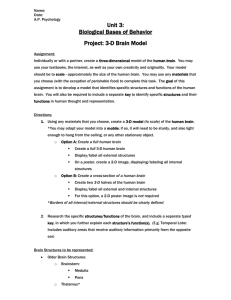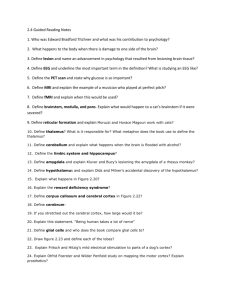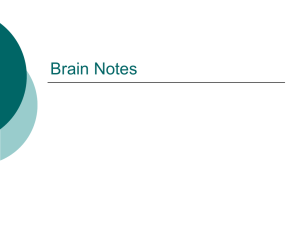The Brain
advertisement
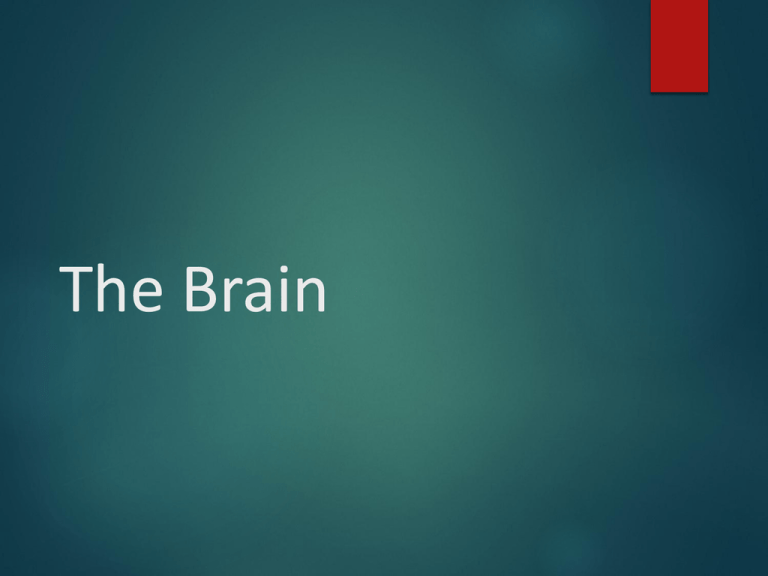
The Brain Lower-Level Brain Structures: The Brainstem Brainstem The oldest part and central core of the brain; It begins where the spinal cord swells as it enters the skull Is responsible for autonomic survival functions Brainstem Medulla Located at the base of the brainstem Controls life-supporting functions like heartbeat and breathing Damage to this area can lead to death. Medulla Reticular Formation A nerve network in the brainstem that plays an important role in controlling wakefulness and arousal Extending up and down the spinal cord into the brain Controls an organism’s level of alertness Damage to this area can cause a coma. Lower-Level Brain Structures: The Thalamus Thalamus Sits atop the brainstem The brain’s sensory switchboard – Directs messages to the sensory receiving areas in the cortex Thalamus is Greek for “inner chamber.” Thalamus Lower-Level Brain Structures: The Cerebellum Cerebellum Latin for the “little brain” Attached to the rear of the brain Helps coordinate voluntary movements and balance If damaged, the person could perform basic movements but would lose fine coordination skills. Cerebellum Cerebellum Lower-Level Brain Structures: The Limbic System Limbic System A ring of structures at the border of the brainstem and cerebral cortex Helps regulate memory, aggression, fear, hunger, and thirst Includes the hypothalamus, hippocampus, and amygdala Hypothalamus A neural structure lying below the thalamus Regulates the body’s maintenance activities such as; eating, drinking, body temperature, and it linked to emotion Plays a role in emotions, pleasure, and sexual function Hippocampus A neural center located in the limbic system that wraps around the back of the thalamus Helps processing new memories for permanent storage Looks something like a seahorse Hippo is Greek for “horse.” Amygdala Two almond shaped neural cluster in the limbic system Controls emotional responses such as fear and anger The Cerebral Cortex Cerebral Cortex The intricate fabric of interconnected neurons that form the body’s ultimate control and information processing center Covers the brain’s lower level structures Contains an estimated 30 billion nerve cells Divided into four lobes Corpus Callosum The large band of neural fibers that connects the two brain hemispheres and allows them to communicate with each other Is sometimes cut to prevent seizures Corpus Callosum Longitudinal Fissure The long crevice that divides the cerebral cortex into left and right hemispheres This and other fissures in the brain create major divisions in the brain called lobes Frontal Lobes The portion of the cerebral cortex lying just behind the forehead Is involved in planning and judgments Includes the motor cortex Parietal Lobes The portion of the cerebral cortex lying on the top of the head and toward the rear Includes the somatosensory cortex and general association areas used in processing information Regions available for general processing, including mathematical reasoning Designated as the association lobes Behind the frontal lobes Occipital Lobe The portion of the cerebral cortex lying at the back of the head It includes the primary visual processing areas of the brain Temporal Lobes Includes the auditory (hearing) areas of the brain Where sound information is processed Located roughly above the ears Motor Cortex The strip of brain tissue at the rear of the frontal lobes Controls voluntary movement Different parts of the cortex control different parts of the body. The motor cortex in the left hemisphere controls the right side of the body and visa versa. Somatosensory Cortex The brain are located in the front of the parietal lobes Registers and processes body sensations Soma is Greek for “body.” MODULE 7: THE BRAIN Differences Between the Two Hemispheres Hemispheric Differences “Left-brained” and “right-brained” debunked Brain is divided into two hemispheres but works as a single entity. Both sides continually communicate via the corpus callosum, except in those with split brains. Differences Between the Two Hemispheres: Language and Spatial Abilities The Brain’s Left Hemisphere For most people, language functions are in the left hemisphere. For a small percentage of people, language functions are in the right hemisphere. Broca’s Area The brain area of the left frontal lobe Directs the muscle movements involve in speech If damaged the person can form the ideas but cannot express them as speech Wernicke’s Area A brain area of the left temporal lobe Involved in language comprehension and expression Our ability to understand what is said to us Usually in the left temporal lobe The Brain’s Right Hemisphere Houses the brain’s spatial abilities Our spatial ability allows us to perceive or organize things in a given space, judge distance, etc. Helps in making connections between words Split Brain Research Split Brain Research Split Brain Research Split Brain Research Split Brain Research Split Brain Research Split Brain Research


